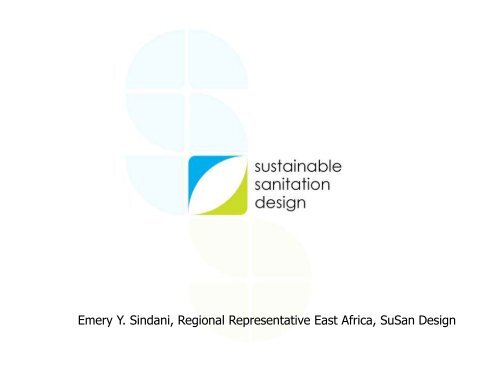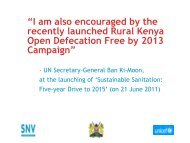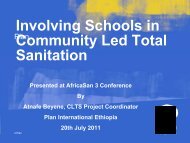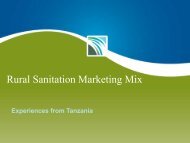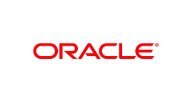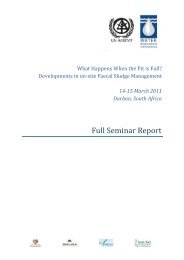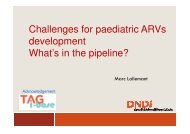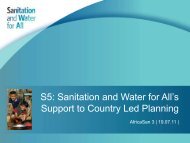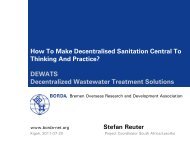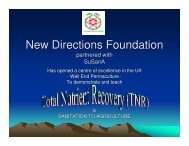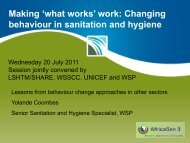2 SuSan Design - Linking Agriculture and Sanitation.pdf
2 SuSan Design - Linking Agriculture and Sanitation.pdf
2 SuSan Design - Linking Agriculture and Sanitation.pdf
Create successful ePaper yourself
Turn your PDF publications into a flip-book with our unique Google optimized e-Paper software.
Emery Y. Sindani, Regional Representative East Africa, <strong>SuSan</strong> <strong>Design</strong>
Technical Cafe – AfricaSan 3, 20 th July 2011<br />
<strong>Linking</strong> <strong>Agriculture</strong> <strong>and</strong> <strong>Sanitation</strong><br />
How business-driven partnerships can create lowcost<br />
services to the urban poor<br />
Keywords: urban slum, <strong>Sanitation</strong> for all, robust treatment, safe natural fertilizer,<br />
<strong>and</strong> agricultural development<br />
www.susan-design.org 2
Why innovation & business<br />
Start up in 2007 – <strong>SuSan</strong> <strong>Design</strong> founder Karsten Gjefle was responsible for industrial<br />
designers - sanitation products needed to be improved – going to scale needed more then<br />
products released to the market – we need VALUE CHAINS <strong>and</strong> INCOME CREATION<br />
Initial research showed that:<br />
• 30 years of NGO/development partner involvement – no or poor results<br />
• New approaches <strong>and</strong> products are needed to h<strong>and</strong>le the sanitation crisis<br />
• Need to think in value chains from home to farm to become sustainable infrastructure<br />
• Determine the incentives for growth<br />
– Home units suited for urban slums<br />
– Produce eco friendly fertilizer, valuable <strong>and</strong> natural<br />
– Owners of public toilets must make a good living – farmers too<br />
– micro financing frees us from the donors <strong>and</strong> their always changing priorities<br />
– Urban renewal must focus on sanitation<br />
– Community appreciation when clean up can start – health effects kick in<br />
3
Goals<br />
Development <strong>and</strong> implementation of a<br />
sustainable value chain for collection of<br />
household biomass <strong>and</strong> human excreta as<br />
platform for production of natural agricultural<br />
inputs, biochar <strong>and</strong> delivery of sanitation<br />
services to the communities
Why sanitation <strong>and</strong> how do we think?<br />
<strong>Sanitation</strong> is key in creating better cities<br />
<strong>and</strong> a dignified, healthy life in urban<br />
Africa. To create low cost quality<br />
sanitation options, value chains need to<br />
be developed to secure income from<br />
the system. Toilet services,<br />
maintenance, collection of valuable bio<br />
materials <strong>and</strong> treatment will be<br />
converted to agricultural inputs that can<br />
be sold to commercial agriculture <strong>and</strong><br />
flower production around Kampala.
<strong>Sanitation</strong>:<br />
an engine of economic growth for Africa<br />
Keywords economic perspective:<br />
Low initial investment<br />
sanitation business ownership<br />
Quality logistics<br />
job creation<br />
natural fertilizer production<br />
Safe soil improvement product<br />
food security<br />
Health in town <strong>and</strong> healthy food<br />
education<br />
6
“EcoSan is the future of sanitation, not a step towards water based solutions”<br />
* <strong>SuSan</strong> <strong>Design</strong> is a business minded foundation focusing on going to scale solutions<br />
• Incentive based approach for improved management<br />
• Low technical complexity – industrial production of units for low prices & high quality<br />
• Easy <strong>and</strong> hygienic logistics all the way<br />
• Income from fertilizer <strong>and</strong> soil improvement products by sale to commercial farmers<br />
• Income generated will finance maintenance, motivate investment <strong>and</strong> roll out<br />
• Integration of micro financing from the start so we don’t get caught in donor red tape<br />
• Urban slums display a comparative advantage with high population concentration<br />
• Franchise assures training, flow of products <strong>and</strong> the quality assurance within system<br />
• Will create employment, pride, health <strong>and</strong> dignity within the community<br />
• Slum upgrade can only be successful after the sanitation issue is dealt with<br />
7
Some numbers – 2,6 billion do not have a toilet<br />
In Africa 200 million people live in urban slums without toilets…<br />
Sub-Saharan Africa slum-dwellers = 72 per cent of urban population<br />
In the next 30 years, the global number of slum-dwellers will be two billion !<br />
100.000 people - 50 % collection rate = 25 tons of industrial fertilizer/month<br />
1 kg of industrial fertilizer in Ug<strong>and</strong>a is over 1 USD<br />
Soil improvement is needed all across Africa<br />
<strong>SuSan</strong> <strong>Design</strong> is science based so faecal sludge can become 99,99% SAFE<br />
The challenge is to create the hygienic <strong>and</strong> efficient logistics<br />
8
The project set up in Kampala
Government <strong>and</strong> donors need to invest in<br />
productive sanitation<br />
Payback on investment at least 10 : 1<br />
The partners hip in Kampala will deliver:<br />
A model for urban slums starting in Kampala<br />
Framework of scaling up to other countries in Africa<br />
Urban sanitation – health <strong>and</strong> dignity<br />
Sale of pathogen free natural fertilizer<br />
School sanitation – better products needed<br />
Food security, health savings, girls education completed<br />
<strong>and</strong> CO2 reductions<br />
Economic growth
% Coverage<br />
The international community has failed<br />
(We just have to do better then this…)<br />
(Source – UNICEF statistics)<br />
80<br />
70<br />
60<br />
50<br />
40<br />
30<br />
20<br />
10<br />
0<br />
Urban <strong>Sanitation</strong> - lack of progress in Africa<br />
1990 1995 2000 2006<br />
Year of data<br />
Burundi<br />
Central African Republic<br />
Chad<br />
Congo<br />
DRC<br />
Djibouti<br />
Eritrea<br />
Ethiopia<br />
Kenya<br />
Malawi<br />
Mali<br />
Mozambique<br />
Rw<strong>and</strong>a<br />
Somalia<br />
Sudan<br />
Swazil<strong>and</strong><br />
Ug<strong>and</strong>a<br />
Zambia<br />
Zimbabwe<br />
11
What is special of the <strong>SuSan</strong> <strong>Design</strong> approach<br />
The Team:<br />
Product <strong>and</strong> service designers – low cost can also be high quality products<br />
the scientists – cooperation between SLU of Sweden <strong>and</strong> Makerere University<br />
agricultural focus - Ug<strong>and</strong>a Cooperative Alliance <strong>and</strong> NARO in Ug<strong>and</strong>a<br />
Communities: SSWARS, SWAGAN<br />
Information gathering from all kinds of sanitation partners in Ug<strong>and</strong>a 2007-08<br />
Analysis of the many reports with poor results<br />
We base our structure on:<br />
Science on how to assure safe agricultural inputs – cheap, fast & reliable<br />
<strong>Design</strong> brief – system description that identified knowledge gaps<br />
Product design of urinal, toilets structure, treatment unit<br />
Market study of urine<br />
Risk assessment for the logistics based on the treatment system<br />
PhDs giving solid evidence of a robust treatment process<br />
12
The competition:<br />
Sewage based systems: a case of triple loss<br />
1. high investment in water production <strong>and</strong> pipes for transport + maintenance<br />
2. loss of nutrients needed for food production – economic burden to replace<br />
3. massive pollution of water ways – degradation of natural capital<br />
Believe it or not: it’s still on the agenda as a possible solution…<br />
‘REINVENTING THE TOILET’<br />
Bill Gates Foundation<br />
‘REINVENTING SANITATION APPROACH’<br />
Sustainable <strong>Sanitation</strong> <strong>Design</strong><br />
13
Trends giving potential<br />
Innovation needed<br />
• High energy prices<br />
• Raising (industrial) fertilizer cost<br />
• African farmers/soils need natural<br />
alternative to increase productivity<br />
• Cities need sanitation systems<br />
• No results from 30 years of<br />
NGO/Gov/dev cooperation<br />
• Population doubles in 25 years<br />
• Urban growth of 3-7%<br />
• Sustainability – Eco friendliness<br />
• Product focus during start up<br />
• By underst<strong>and</strong>ing the volumes +<br />
potential + dynamics = Urban<br />
slum sanitation value chain<br />
• Treatment challenge of 1000 tons<br />
of shit <strong>and</strong> 2000 m3 of urine ?<br />
• Create the economics<br />
• Only safe products should be sold<br />
for money<br />
• Transfer the science to treatment<br />
methodology to be decentralized<br />
• Create cooperatives or franchise<br />
structure to maintain quality<br />
14
Urban slum is our main focus<br />
1. Urban Slum <strong>Sanitation</strong> from home to farm – Value chain development<br />
‣ Home unit<br />
‣ Urban public unit<br />
‣ Secondary treatment unit<br />
‣ Delivery to farmers<br />
2. School <strong>Sanitation</strong><br />
‣ Urban schools with delivery to the secondary treatment unit<br />
‣ Decentralized solutions with school sanitation units run by local farmers – this unit will<br />
increase the lifespan of toilets in schools from months to many years…<br />
Other areas of interest<br />
3. Refugee camp version of urban public unit<br />
4. Hotel/Lodge/tourist camp version<br />
5. Home unit – pit latrine EcoSan conversion kit<br />
16
The volumes <strong>and</strong> value<br />
Urine<br />
Average 1,4 liters pr day<br />
Collection rate 30%<br />
For every 100.000 users<br />
= 1260 m 3 pr month<br />
Assuming medium rate of N (80 liters = 1 kg)<br />
= 15,75 tons kg industrial fertilizer pr month<br />
Solids<br />
Average 0,3 kg<br />
Collection rate 60% (should be higher)<br />
For every 100.000 users<br />
= 540 tons per month (before treatment)<br />
Important for soil quality<br />
= treatment cost 30-40 $ pr ton<br />
Sludge integration training to farmers<br />
Use of urine – how <strong>and</strong> when – research needed on productivity gains<br />
The safe soil improvement product will improve long term productivity<br />
Can the farmers trained become school sanitation managers?<br />
How can the sanitation unit in urban areas become a viable business?<br />
17
home Unit - Introduction<br />
Product: Susan <strong>Design</strong> Unisex Urinal<br />
Background: Women in slums suffer<br />
greatly by not having a place to pee<br />
during the day<br />
<strong>Design</strong>ed in close cooperation with<br />
women in the slums of Kampala<br />
Maintains the fertilizer quality of urin<br />
Very valuable for the disabled<br />
designer: Sarah Keller<br />
prototype development: Øyvind Grønlie, <strong>SuSan</strong> <strong>Design</strong>
Prototype Assembling of Urinal for Home Unit
URINAL USABILITY<br />
Urinal User-friendliness<br />
joy<br />
satisfaction<br />
convenient<br />
time saving<br />
safer during the nights<br />
Odorless<br />
giving privacy<br />
clean<br />
easy to use<br />
reduced chances of infection<br />
an alternative to disgusting toilet facilities<br />
the right size<br />
A pre-unit pupil (5 years old) using a<br />
urinal
Urban public unit<br />
• To be developed based on design brief<br />
• Target: 10 – 12 toilets as a unit run as a business by local<br />
entrepreneurs<br />
• All units part of the franchise structure<br />
• Receive micro financing <strong>and</strong> training<br />
• Toilet income: small fee for toilet visit – urinals are free of charge<br />
– sell urine to farmers – shop with hygiene products, air time etc.<br />
• 600-1000 users per unit in urban slums across Africa<br />
<strong>SuSan</strong> <strong>Design</strong> will develop, outsource production <strong>and</strong> sell the units<br />
22
The Treatment Unit<br />
Background:<br />
The spread of disease is from non hygenized fecal matter. Composting or pit latrine storage does not give a safe<br />
agricultural input. Dry toilets with urine diversion enhances the reuse aspect. The treatment is done to assure<br />
that the urine <strong>and</strong> the soil improvement product is safe <strong>and</strong> maintains its nutritional value.<br />
Urine<br />
can carry bacteria <strong>and</strong> virus if contaminated from feacal matter. Cross contamination is minimized by incentives to<br />
use urinals, a well designed squat pan <strong>and</strong> clear user guidelines.<br />
Treatment of urine:<br />
Storage of 2-6 weeks depending on risk evaluation will create a safe agricultural (natural) fertilizer. Risk<br />
evaluation <strong>and</strong> guidelines have been developed with the University of Life Sciences <strong>and</strong> field testing will be done<br />
in cooperation with National Agricultural Research Organization in Ug<strong>and</strong>a for implementation with farmers.<br />
Treatment of solids:<br />
A team of researchers from the Swedish University of Agricultural Sciences has developed a cheap <strong>and</strong> easy to<br />
use hygienisation methodology for feacal matter that produces a safe soil improvement agent. 4% urea is added,<br />
neutralizing the pathogens <strong>and</strong> enhancing the fertilizer <strong>and</strong> soil improvement qualities of the solids.<br />
Cost:<br />
20-30 USD pr. ton of fecal matter + transport. The challenge is to create a structure for treatment that assures<br />
the safety of every batch. We have a worked on this aspect but in this situation we will need to create training<br />
manuals <strong>and</strong> teaching materials to transfer this knowledge. The process adds qualities to the solids improving the<br />
fertilizer value <strong>and</strong> soil improvement qualities of a product that the farmer needs.<br />
Storage time 4 week in closed containers with minimum 20° C<br />
<strong>SuSan</strong> <strong>Design</strong> all rights reserved<br />
www.susan-design.org<br />
23
Reports <strong>and</strong> research done<br />
• <strong>Design</strong> brief for urban slum value chain – public unit – Ug<strong>and</strong>a<br />
• Risk assessment for the value chain – treatment in particular<br />
• Market study for urine in Kampala showing a sustainable income for units<br />
run by entrepreneurs in Kampala<br />
• Paper published: “<strong>Sanitation</strong> - an engine of economic growth”<br />
• Preliminary business plan developed – needs revision<br />
• Treatment methodology is science based with several Phds available<br />
• Testing of prototype Uni-sex urinal in Nairobi done with German GIZ<br />
• Emergency card UD toilet developed to prototype – not field tested yet<br />
• Strategy for productive school toilets for Africa<br />
• Toilet structure design for urban areas – cheap, solid <strong>and</strong> flexible –<br />
prototype to be tested in Kampala 1 st Q 2012.<br />
And more…<br />
24
• MERCI MINGI<br />
• ASANTE SANA<br />
• DANKE SCHOEN<br />
• MERCI BEAUCOUP<br />
• MURAKOZE CYANE<br />
• THANK YOU VERY MUCH<br />
<strong>SuSan</strong> <strong>Design</strong> all rights reserved<br />
www.susan-design.org<br />
26


